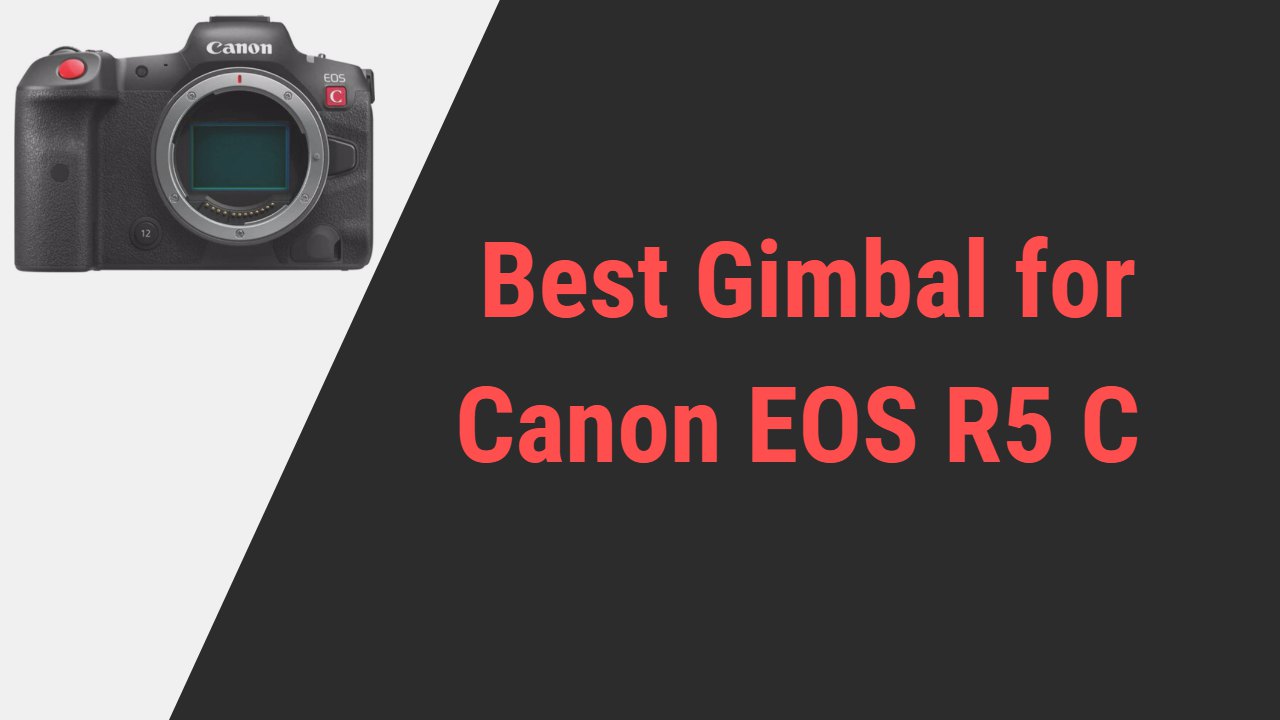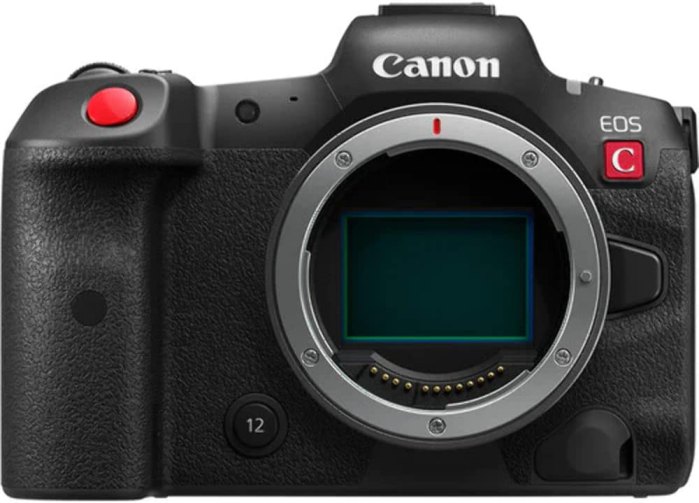There are some things that have the power to steal your heart at first glance; undoubtedly, this dazzling piece of perfection Canon EOS R5 has that potential. The high-tech professional mirrorless camera is surrounded by some intriguing features making its efficiency way ahead in the race of best cameras. The professional camera with upgraded sensors, intellectual verdicts, and design has the simplest control, which makes it easy for the entry-level photographer.
However, the only digital image stabilization of the camera makes things a little incomplete; Not anymore because I have found the best solution for the scenario: Gimbals. Camera stabilizers are a tool to enhance camera productivity, but the gimbals are referred to as essential because, in the way to cinematic shots, one must have the side hand of a professional tool.
Canon EOS R5 C
Note:
Currently, there is only one gimbal in the market that supports the EOS R5C Camera. The link to the setup method and control features is added in the table.
The gimbal mentioned here is tested with Canon EOS R5C and works perfectly fine.
| DJI RS 3 Pro (Most High-end - Highest Payload Capacity & Comes with Advanced Features)

|
The gimbal is effortlessly easiest to control, and they intend to pour corner-to-corner balance even when filming the fastest-running subject. This is why I recommend a powerfully ideal Gimbal to accompany the EOS R5 C usage in order to kick-start the cinematic aspect of the camera.
Among all the variations in the ocean, I prefer this special gimbal that satisfies the category of being the best for Canon R5 C expertise. Let us have a quick look over its quality specification that you can admire.
Best Gimbal for Canon EOS R5C
1. DJI RS 3 Pro
Overview– Nothing can be more artistic than utilizing the immense abilities of EOS R5 C with the rightful pairing of Gimbal; Among gimbal’s vast variations, I would trust none more than the iconic DJI brand.
The brand has been serving wonderful appliances for a while but the upgraded, magnificent edition DJI RS 3 Pro has definitely an out-of-ordinary class.
Placing the high-leveled enhanced potential of EOS R5C in the hand of advanced DJI RS 3 Pro is the most satisfying way to embrace professional footage. Let’s have a deep look over the fact “Why.”
A quick peak at Gimbal’s Features-
- Brand– DJI Ronin
- Payload– 10 pounds
- Weight– 3.3 Pounds
- Battery– Lithium-ion- 3000 mAh
- Runtime– 12 hours
- Charging Time– 2 Hours
About DJI Ronin
DJI, officially known as SZ DJI Technology Co., ltd, is an iconic China-based organization that originated sixteen years ago in 2006. The brand has been active in manufacturing some high-leveled innovative photography and videography tools.
DJI is abbreviated for Da-Jiang Innovations which was initiated and headquartered in Shenzhen, China itself. The brand is wisely famed for its wonderful, reliable service of camera gimbals, drones, camera stabilizers, and other photography appliances.
What’s best in the DJI Ronin RS 3 Pro gimbal?
Honestly, everything, every single inch of the gimbal is filled with creativity. Theoretically, the DJI RS 3 Pro gives so much to flaunt when it comes to innovation, digging down a little, let’s face the clear fruitful functions of the gimbal that are destined to make photography better.
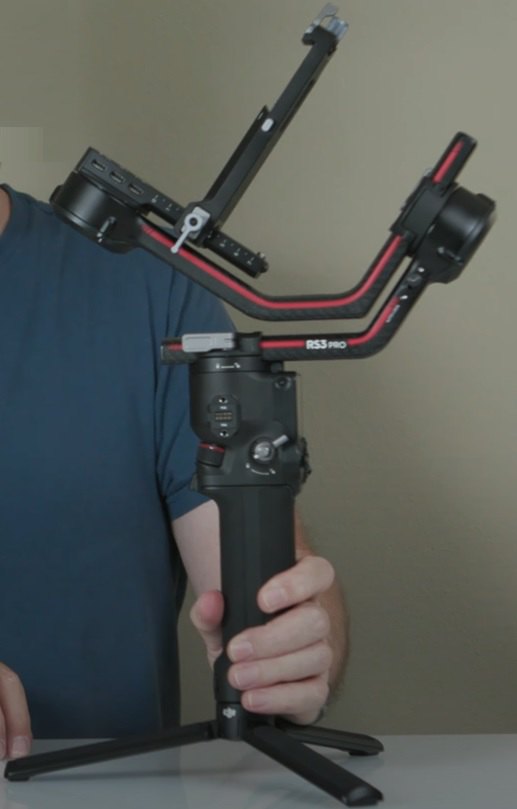
Calibration– The mounting system of the gimbal is wonderfully amazing. Not just the lightest camera like EOS R5 C, but any heavier camera also can be situated easily. The easy set, slide, and lock mechanism followed for the mounting of the camera.
However, it’s the effective Quick-release dual-layered plates that made things more exciting. These plates assure that there won’t be any hassle of rebalancing the camera or swapping the battery after the camera is settled.
On top of that, the gimbal also has the effective automated Axis lock one that can be locked and unlocked accordingly to expand the horizon and shoot different angles.
This automated axis lock is super easy to operate; all you have to do is press and hold the power button, and things get done. The power button extended pressing once can also lock the gimbal in sleep mode.
Controls– there are numerous things you can do with the gimbal support, as the control accessibility given by the camera is easiest. First will be the wireless or remote control; the gimbal allows it to be controlled via the Ronin official application.
Gimbal also grants freedom to use the high-bright remote monitor with the little help of Ronin 4D hand grips or DJI Master wheels. This remote monitor allows direct control of essential settings when your camera is situated a little far. The gimbal remote control needs a reliable wireless connection that can be achieved with effective Wi-Fi or Bluetooth.
The second will be the physical or integrated controls. There are a few; when you need to switch the shooting mode (between pan follow, pan and tilt follow, or FPV), the simple slider comes in handy.
In contrast, the fine-tuning knob manages the camera position (from sliding forward and backward) for balance. The front dial that can be rotatable allows zooming and focusing. But the additional Teflon-coated component eases the lower friction resistance that balances the heavy camera.
Creativity– With the inspiration of “More Power, smaller effort,” the gimbal tried to pour as much stabilization technique as possible. The upgraded third-generation RS stabilization algo grants 20% enhanced stability over the fast-running subject. Also, the increased motor torque of the gimbal results in enhanced super smooth results in the low-angle shots and high-low positioned ones.
The creativity gets the kick with the promise of better vision, one that can be achieved by the in-built full-colored OLED panel with the smartest user interface.
The panel is sized at 1.8 inches and with the fingertip touch control support only to provide a 28% larger display than its other predecessor. The screen is useful in showing the basic setting parameters and other controls.
Engineering– Nothing can beat the gimbal when it comes to strength and power. Unlike the other gimbals, this one is configured with a highly durable Carbon Fiber composite, one that increases the rigidness and the stiffness but also lowers the weight at the same time. This explains the lightest 3.3 pounds only.
Even with such the least weight, as you have seen, the gimbal is designed to carry the highest payload of 10 pounds. These 10 pounds include not only the camera but also third-party accessories.
Speaking of which, the gimbal has extensive ports like the dual RSA and NATO ports that can attach numerous effective accessories like the twist grip dual handle, Tethered control handle, and much more, all easily as pie.
Power– The gimbal is labeled as a professional tool that explains the enormous power it has to back up its innovative features. The outer gimbal design has a cartridge designed with an updated battery grip, which is equipped with an all-powered lithium-ion polymer battery. The newly designed battery grips keep things smooth and straightforward while swapping batteries.
The batteries are in-built and empowered with the 1950 mAh enough to grant 12 hours straight working on a single charge. With the right pairing of DJI 18-watt PD fast charger and its quickest filling technique, the gimbal’s potent batteries take not more than 1.5 hours to be recharged again.
Additional– The gimbal supports the additional artisticity that can be possible through many alternatives. Like the LiDAR focusing technology supported by a gimbal that makes focusing easier with the new optional range finder that projects the ranging points from a certain distance.
Another is the Active Track Pro support that can monitor or even frame the subject through the OLED screen of the gimbal, which is pretty amazing. The gimbal also has this wonderful DJI RS SDK protocol or program that allows the gimbal to expand its enticing features for extensive scenarios to frame better.
Bottom Line- So, haven’t you already learned so far there is absolutely no match for the DJI RS 3 Pro? Count with me, the better stabilization, the better-engineered body, the better controls and power that would be needed more in the way to achieve the cinematic-looking shot.
Considering the fruitful features of the gimbal; I figured the price pretty reasonable and trusted nothing can beat it when it comes to EOS R5 C. So go for it.
What are the things I like most in DJI RS 3 Pro
- Improved Auto Axis Lock
- Upgraded stabilization and motor
- Support Active Track Pro expertise
- Super Durable Carbon Fiber build
- Effective LiDAR focusing technique
- Highest payload and lightest weight
- Largest vision with 1.8-inch OLED
- Easy yet secure calibration support
- Enhanced and longest surviving battery
- Extensive ports and DJI RS SDK support
What can be improved in Dji RS 3 Pro
- Weight can be an issue with a heavy camera
- Can be hectic to set up the whole thing
Why DJI Ronin RS 3 Pro is best for Canon EOS R5 C
Okay, you might be already wondering that there are tons of Gimbal options available in the market; why choose this one? So let me clarify a bit. There’s a saying, “We don’t choose the gimbal for the camera; the Camera chooses the gimbal itself.” This is what happened here. The high-tech advanced DSLR EOS R5 C has chosen this particular gimbal to collaborate with for many reasons.
Weight– The DJI RS 3 Pro is designed to carry the heaviest camera model; the EOS R5 C, with the 1.7 pounds weight, is a piece of cake for the gimbal. The gimbal 10 pounds payload is way too convenient for the camera, even with the additional third-party accessories.
Battery– The gimbal 3000 mAh battery and the ability to work the longest straight is the charm for the LP-E6NH lithium-ion battery used in EOS R5 C. The constant 320 shots of the camera are backed up by the gimbal’s 12 hours of working.
Stabilization– The EOS R5 C does include digital image stabilization only, which is why the upgraded stabilization technique of the DJI RS 3 Pro fits like a limb to enhance the efficiency in the image quality and provide cinematic-looking footage.
Strength– Something as precious as EOS R5 C couldn’t afford to fall accidentally during the shoot. This is why DJI RS 3 Pro, the gimbal with the strongest carbon fiber construction and rigid strength, secures the camera.
Optics– The creativity of shooting function motions and different modes, including the 3D roll, portrait, and FPV mode, make things better for the 45 Megapixel EOS R5 C.
Designing – I admit EOS R5 C has the most compact design and body, but it would be more convenient and safer. The DJI RS 3 pro easy mounting has secured the R5 C quite conveniently around the way to do the work.
How to Mount the DJI RS 3 Pro on the Canon EOS R5 C
As I have mentioned, setting the Canon EOS R5 C on the Gimbal DJI RS 3 Pro is not a big deal; because of the courtesy of gimbal, the whole calibration process is considerably smoother and more secure.
Other than the camera itself, the gimbal has the potential to carry accessories, so get started with your Raven Eye, focus motor, or other tools.
I am starting with the top; if you are a beginner or trying out the first time with DJI RS 3 Pro, let me classify the whole setting of the camera into three categories. Install the gimbal, set the camera, and manage the balance.
Installing – The very first step of the collaboration of the gimbal and camera will include the installation of the gimbal itself.
- I will start with getting a flat surface for a good base situating
- Expand the tripod from the package and place it first
- Attach the battery grip to the tripod by screwing it firmly (Make sure your battery is fully charged to avoid interruption
- Above the battery grip, you see a clear metal contact on which seat the gimbal down nice and rigidly and lock the thing
- Now the gimbal is ready to be in action; however, before the camera attaches, position the axis at the right open angle
Camera calibration– Once the gimbal is all set and securely stands, the next thing needed to be done will be the installation of a camera on it.
- For which take the base plate that came into the packaging and pull it in the gimbal to the adequate position
- In doing so, make sure the base camera is attaching side points upward. Now the base is ready.
- Before camera attachment, ensure the camera battery is fully charged and associated with the right lens and accessories.
- Now take the camera to the base side we have attached earlier and slide the camera in till you hear a little snap.
- Once you hear the snap, it means your camera is in the right position; at that very point, lock the camera securely from the back.
- There, your camera is mounted on the RS 3 Pro body, nice and secure.
Balancing- Like this, your camera is smoothly attached to your gimbal and is ready to shoot cinematic footage.
- Try to attach every essential accessory like the storage card, lens, and focus motor before the camera mount to avoid dis-balancing
- Once your camera is all set on the gimbal, the easy, quick-release plates prevent the rebalancing.
- The camera positioning can be done via axis lock, like unlocking the tilt axis and moving the camera upside down, and then again locking the adjacent axis to take a shot of that particular angle.
Control and creative potential of DJI RS 3 Pro with the EOS R5 C
Also, something I have mentioned earlier is that EOS R5 C, an advanced camera, has the greatest compatibility with the DJI RS 3 Pro, not because of its design and engineering.
But also, because the gimbal expands the horizon of innovative controls and stuff you can do when paired with EOS R5 C. The major controls and multi-creativity you can experience with R5C at this RS 3 Pro head-mounted are
- You can capture and switch video and photo filming with ease.
- You can have the one-tap start and stop recording video convenience.
- The gimbal control features grant the freedom of managing the Aperture level during the shoot.
- The ISO and shutter speed range can also be determined and modified in this collaboration.
- The gimbal and camera together explore the fruitful features of the Ronin image transmitter (Ronin RavenEye Image transmitter)
- Under its controls, this image transmitter grants a live camera view through the Active Track 3.0
- The resting power, shooting modes, and setting parameters can be viewed at the gimbal’s largest display screen.
Tips for exploring and mastering the controls
So these are the exquisite controls, and creative convenience one can get while shooting with EOS R5 C at DJI RS 3 Pro head. The access to the basic settings is way too innovatively approached to the photographer’s usage, making every footage go professional.
However, few tips and tricks exist that can enhance the gimbal’s efficiency to the highest so that you can enjoy the artistic spirit of both the gimbal and the camera.
These tips are also classified into two categories by me. One that manages you to master the control of tools throughout the filming, and the second will be the secret hack that brings uniqueness to your cinematic shot.
Tips for mastering the DJI RS 3 Pro’s control
- While shooting the still photo, make sure the gimbal is in photo mode to take photos.
- Similarly, while recording the film, ensure the gimbal is in video mode to film the frame.
- Remember, if you are using RavenEye through the HDMI, the camera screen doesn’t show any images that were in the frame.
- If you desire to display images on the camera screen in photo mode, do not include any connecting monitor or RavenEye.
- To experience the unrivaled competency of focus pull, you have to go full Auto mode.
- So when opting for the focus pull, make sure your lens focus mode is Autofocus, and the AF Servo of the camera focusing Is off.
- Use the right lens, which is the RF lens, to experience better focusing.
- If using others like EF lens, associate the adequate adapter for the focus latency.
- To Avoid storage complications, wait a little while after the recording video. Once the video storing in the tool is completed, then and only then start recording again.
- The video storing is complicated and can be identified when the camera recording indicator displays a green light.
- If you start recording before flashing the green light, the camera will freeze, causing disruption in filming.
DJI RS 3 Pro general tips for embracing professionalism
- Try to walk backward and manage the speed and action of the subject
- Explore filming using all the three axes of RS 3 Pro to get a more cinematic shot
- Always choose the longer lenses to make the footage look cinematic
- Try taking the low-angle shot because the camera is close to the floor; gave a creative perspective
- Keep the sensitivity lower to avoid jittering in the fastest movement
- For the longer period of filming, keep the gimbal close to your body to avoid strain on the hand
- Embrace artistic vibes through different shooting modes like drone shots, crane shots, lateral shots, or torso shots.
- Lock your camera in the right place and avoid the camera turning during the shoot
Know your Camera Canon EOS R5C
Canon is a wise name in the world of photography; the brand that’s been popular for producing some magnificent tools with the greatest power.
Canon has launched this exquisite beast with so much potential, versatility, and an intention to provide flawless cinematic footage. Canon EOS R5 C is a full-frame mirrorless camera that was brought into the spotlight very recently in April 2022.
The C in the name justifies the Cinematic factor, which is why the camera is also called Canon EOS R5 C cinematic camera. Compared to its sibling camera, the EOS R5 C possesses immense intelligence and sharp optic providing ability, and all that comes with a decent price tag of 4499 dollars for body only.
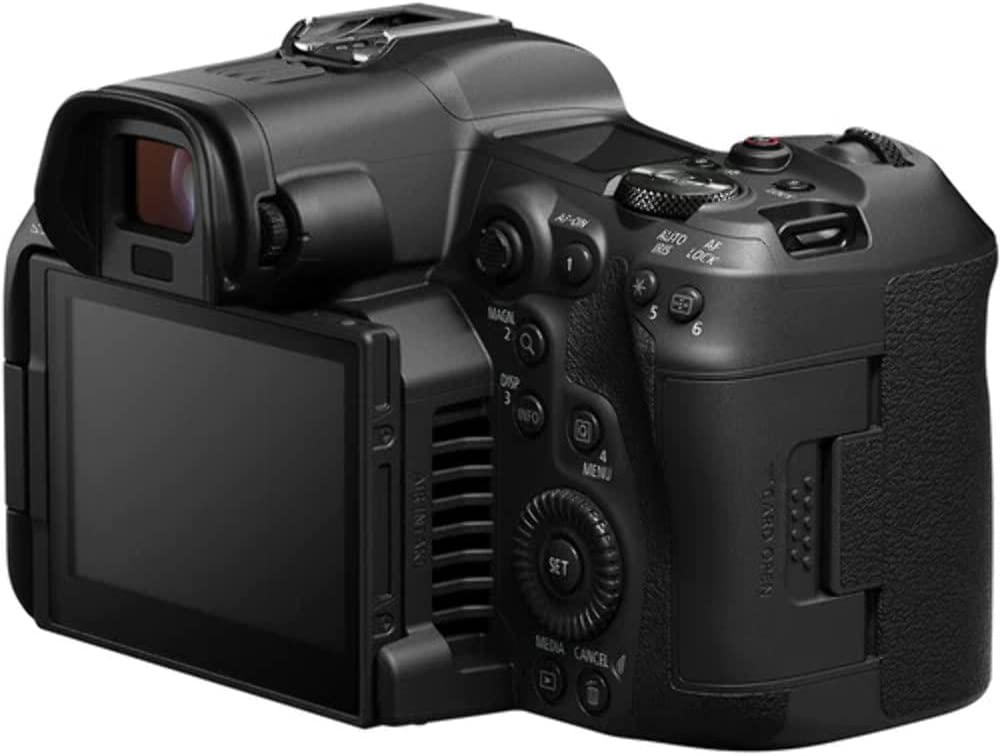
The EOS R5 C is filled with such excellency, which suits best for high-performing stuff like wedding, event, or multimedia journalism shooting which is why it is called a right professional tool.
The camera has an enhanced number of features that show unlimited creativity, but the best one is its ability to shoot cinematic videos. There is so much about the camera that defines how dedicatedly the brand has curated the model; let’s count them together.
Mouthful features of Canon EOS R5 C
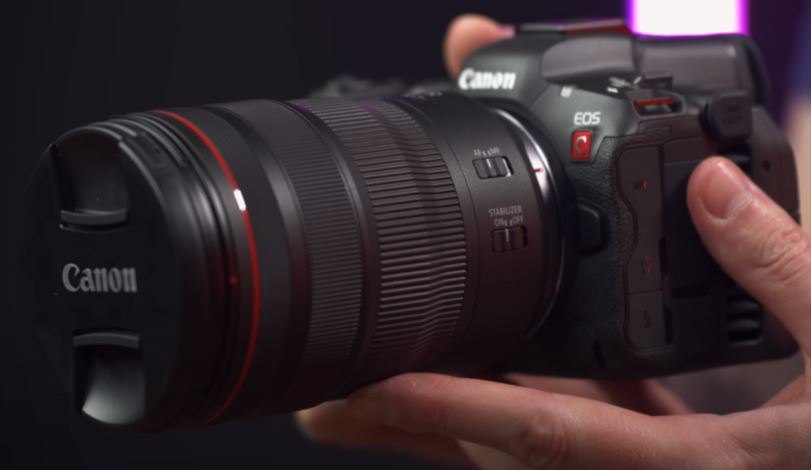
Before Diving into the world of creativity, let’s get you a nice and long look over some fascinating specifications of Canon EOS R5 C.
Shooting– the camera uses the configuration of a Digic X processor with a CMOS sensor size of 45 Megapixels, one that shoots some flawlessly clear and splendid shots.
Filming– The camera is beastly and is potent enough to shoot 8K video at 60p, 5.7K at 60p, and Ultra HD 4K video at 120p. The camera allows internal recording for an unlimited period.
ISO– The camera allows filming during dark hours because of its effective Auto ISO. The auto ISO has a sensitivity level for the photo from ISO 100 to ISO 51200 that can be extended to ISO 102400. And for video, ISO 100 to ISO 12800 can be extended to ISO 51200.
Focus– The advanced camera serves both auto and manual focusing with the different continuous-Servo AF, Manual focus, and single-servo AF modes; that have the 1053 phase-detection points
Vision– The camera is constructed with an in-built OLED viewfinder that is sized wide at 0.5 inches. The viewfinder has a 5.79 million dot resolution and 100% wide coverage for a better display of the frame.
Display– Apart from the viewfinder, the camera also has this super intuitive Free-angle tilting LCD with touch orientation; broadest with 3.2-inch size and 2100K dot resolution, and a brilliant user interface.
Speed– The camera has the highest continuous shooting speed, which is up to 12 frames per second with a mechanical shutter and up to 20 frames per second with the electronic shutter; Both with the 45 Megapixel
Shutter– The camera specification includes both an electronic shutter and mechanical focal plane shutter with a speed of 1/8000 to 30 seconds. And a creative approach with adequate metering, exposure modes, and -3 to +3 EV exposure compensation figure.
Storage– the body of the camera is designed to allow two memory card involvement; Slot one allows the CFexpress Type B card while the other Slot requires SDHC and SDXC cards formatted in UHS-II bus format.
Connectivity– The camera has the potential to establish a secure connection that can be used for hassle-free data transfer. This connection can be secured through 5GHz Wi-Fi and Bluetooth technology.
Lens– EOS R5 C is indeed a masterpiece and addition to Canon’s Amusing R digital camera series that have the canon RF mount to be filled with only RF lenses.
Power– The camera filled with such magnificent abilities also includes the lithium-ion battery pack; the battery is empowered to grant 320 constant shots in a single charge. The battery can be recharged with Type C within the quickest period.
Designing– The EOS R5 camera body has the SLR style structuring and is composed of the strongest material that states the durability and strength of the camera.
Portability– The camera has effortlessly straightforward maneuverability, and the weight of the camera stay put least 680 grams only for the body; with the battery and other stuff, the weight rises to 770 grams
Frequently Asked Questions(FAQs)
Q. What makes the DJI RS 3 Pro Best for Canon EOS R5 C?
As I have already mentioned, a lot of things make the DJI RS 3 Pro gimbal quite a match for our EOS R5 C camera. The gimbal and camera body, features, and calibration match and blend like limbs to ensure an authentic and fruitful outcome. The power, potential, innovation, and engineering of every single character of RS 3 Pro compatibility match to go with the advanced features of Canon EOS R5 C. And lastly, the gimbal has a great history of providing ethical and satisfying service, and it does come from a reputed brand which won’t cause harm to precious R5 C.
Q. Is the Canon EOS R5 C worth buying?
Like Canon’s other enchanting creation, this EOS R5 C is also a gem, one that has an attractive design and promising features. The 45-megapixel camera with 8K video shooting ability and so much intellectual to crush on. The better focusing, the never seen low light filming, the straightforward interface, and the fastest shutter speed; everything is super professional in the camera. The strongest body with a powerful battery is something that can be flaunted proudly on. Above all, every control is easiest for usage. So, considering every single feature of the gimbal, investing in this masterpiece is definitely worth every penny.
Q. Is the gimbal essential for EOS R5 C shooting? Why?
I guess so, I believe so. In my time of usage, I determined and side-listed a lot of factors that state that a gimbal association would ease not only the convenience but also enhance the image quality, let alone the professionalism. The EOS R5 C is a video-centric gimbal that comes with digital-only stabilization, which means a little extra hand of additional stabilization can amplify the creativity and professional verdict of the camera. Using Gimbal with EOS R5 C can expose balance imagery, creative modes, effortless and longest operation, and tricky angled shots.
Q. Are gimbals really high maintenance?
Definitely not, Gimbals are not something that requires too much attention or care; they are all stabilizers that crave high maintenance. Gimbals can be used by even beginners. However, to enhance its efficiency and add extra years to its life, there might be a few basic steps you can take to keep your gimbal fit and healthy. Like, make sure you take care of the gimbal’s hygiene and keep the tool clean. Do not overload it with heavy stuff. Keep the unnecessary debris or obstacles away from their way. Store the tool in a secure place.
Final Words
So that’s all, that’s the reason why my decision for the right gimbal is biased towards this one and only DJI Ronin 3 Pro 3-axis gimbal. As much as I would like to explore the market, I settled more on this magnificent piece of work by one of the reputed brands.
When I first confronted the mesmerizing features of RS 3 Pro, it blew away other things I had studied in any other gimbal on the market. The way its immense properties get blended with the fascinating potential of EOS R5 C is way too compelling to watch.
Summing it up a little, you have seen how this gimbal beats every other alternative with its upgraded stabilization, highest payload potent, decent battery, and so much intelligence. Power is also the star of the gimbal, so I believe nothing is left in the way that can cross its dazzling abilities.
So, if you have EOS R5 C, you might need to go a little pro with this wonderful piece that makes an excellent addition to your collection. Although if you have any other gimbal opinions, do not forget to let me know in the comment section below.

